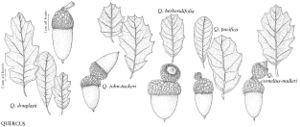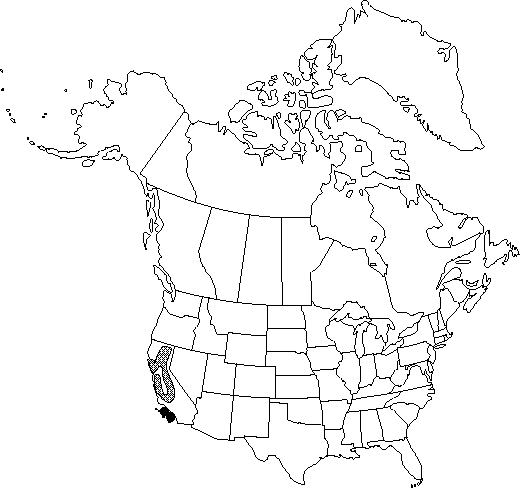Difference between revisions of "Quercus douglasii"
Bot. Beechey Voy. 9: 391. 1840.
FNA>Volume Importer |
imported>Volume Importer |
||
| (7 intermediate revisions by 2 users not shown) | |||
| Line 13: | Line 13: | ||
}}{{Treatment/ID/Special_status | }}{{Treatment/ID/Special_status | ||
|code=F | |code=F | ||
| − | |label= | + | |label=Illustrated |
}} | }} | ||
|basionyms= | |basionyms= | ||
|synonyms={{Treatment/ID/Synonym | |synonyms={{Treatment/ID/Synonym | ||
| − | |name= | + | |name=Quercus douglasii var. ransomii |
|authority=(Kellogg) Beissner | |authority=(Kellogg) Beissner | ||
| − | }}{{Treatment/ID/Synonym | + | |rank=variety |
| − | |name= | + | }} {{Treatment/ID/Synonym |
| − | |authority= | + | |name=Quercus ransomii |
| + | |authority= | ||
| + | |rank=species | ||
}} | }} | ||
|hierarchy=Fagaceae;Quercus;Quercus sect. Quercus;Quercus douglasii | |hierarchy=Fagaceae;Quercus;Quercus sect. Quercus;Quercus douglasii | ||
| Line 30: | Line 32: | ||
}}<!-- | }}<!-- | ||
| − | --><span class="statement" id="st- | + | --><span class="statement" id="st-undefined" data-properties=""><b>Trees,</b> deciduous, with single trunks, sometimes with few to several trunks. <b>Bark</b> gray, scaly. <b>Twigs</b> reddish or yellowish, ca. 2 mm, densely or sparsely puberulent, occasionally glabrate with age. <b>Buds</b> reddish brown, rarely yellowish, broadly ovoid to rarely subglobose, (2-)3-5 mm; scales glabrous except for ciliate margins, sometimes sparsely or densely pubescent. <b>Leaves</b>: petiole blue-green, 2-6 mm. <b>Leaf</b> blade obovate or elliptic, oblong or oblanceolate, (20-)40-60(-80) × (15-)20-30(-40) mm, base rounded-attenuate or rounded, rarely cuneate, margins shallowly lobed or irregularly toothed, sometimes entire, lobes mucronate or rounded, secondary veins 6-10 on each side, apex rounded, rarely moderately acute; surfaces abaxially light green or blue-green, waxy, with scattered to crowded, semi-erect, (2-)4-6(-8)-rayed stellate hairs usually 0.2-0.6 mm diam. or larger, adaxially blue-green, glaucous or grayish, vestiture similar to abaxial surface. <b>Acorns</b> subsessile, solitary; cup hemispheric or cup-shaped, rarely deeper, 5-10 mm deep × 10-15 mm wide, enclosing only base of nut, scales thin and not tuberculate to strongly and irregularly tuberculate, particularly toward base of cup; nut thin-walled, fusiform or subcylindric, 20-30 × 10-16 mm. <b>Cotyledons</b> distinct. <b>2n</b> = 24.</span><!-- |
-->{{Treatment/Body | -->{{Treatment/Body | ||
| Line 37: | Line 39: | ||
|elevation=0-1200 m | |elevation=0-1200 m | ||
|distribution=Calif. | |distribution=Calif. | ||
| − | |discussion=<p>Populations of Quercus douglasii in coastal southern California and on the Channel Islands consist of small stands or solitary individuals often associated with Q. lobata and scrub oaks. Some doubt exists as to whether some or all of those populations are natural stands or are historical introductions near Native American settlements. Along the canyons of Santa Barbara County, putative hybrids between Q. douglasii and Q. dumosa are referred to Q. ×kinselae (C. H. Muller) Nixon. In the interior Coast Ranges of California are found numerous populations that are intermediate in form between Q. douglasii and Q. john-tuckeri (= Q. turbinella var. californica). This appears to be an area of secondary contact, and the two species remain distinct in nearby populations. Because of the widespread nature of the intermediates, following Tucker's extensive studies they can be conveniently referred to as the nothospecies Q. ×alvordiana Eastwood. The plants tend to be shrubs to small trees, with somewhat more spinose leaves than Q. douglasii and fruit similar to those of the latter species.</p> | + | |discussion=<p>Populations of <i>Quercus douglasii</i> in coastal southern California and on the Channel Islands consist of small stands or solitary individuals often associated with <i>Q. lobata</i> and scrub oaks. Some doubt exists as to whether some or all of those populations are natural stands or are historical introductions near Native American settlements. Along the canyons of Santa Barbara County, putative hybrids between <i>Q. douglasii</i> and <i>Q. dumosa</i> are referred to Q. ×kinselae (C. H. Muller) Nixon. In the interior Coast Ranges of California are found numerous populations that are intermediate in form between <i>Q. douglasii</i> and <i>Q. john-tuckeri</i> (= <i>Q. turbinella</i> <i></i>var.<i> californica</i>). This appears to be an area of secondary contact, and the two species remain distinct in nearby populations. Because of the widespread nature of the intermediates, following Tucker's extensive studies they can be conveniently referred to as the nothospecies Q. ×alvordiana Eastwood. The plants tend to be shrubs to small trees, with somewhat more spinose leaves than <i>Q. douglasii</i> and fruit similar to those of the latter species.</p> |
|tables= | |tables= | ||
|references= | |references= | ||
| Line 46: | Line 48: | ||
-->{{#Taxon: | -->{{#Taxon: | ||
name=Quercus douglasii | name=Quercus douglasii | ||
| − | |||
|authority=Hooker & Arnott | |authority=Hooker & Arnott | ||
|rank=species | |rank=species | ||
|parent rank=section | |parent rank=section | ||
| − | |synonyms= | + | |synonyms=Quercus douglasii var. ransomii;Quercus ransomii |
|basionyms= | |basionyms= | ||
|family=Fagaceae | |family=Fagaceae | ||
| Line 60: | Line 61: | ||
|publication title=Bot. Beechey Voy. | |publication title=Bot. Beechey Voy. | ||
|publication year=1840 | |publication year=1840 | ||
| − | |special status=Endemic; | + | |special status=Endemic;Illustrated |
| − | |source xml=https:// | + | |source xml=https://bitbucket.org/aafc-mbb/fna-data-curation/src/2e0870ddd59836b60bcf96646a41e87ea5a5943a/coarse_grained_fna_xml/V3/V3_30.xml |
|genus=Quercus | |genus=Quercus | ||
|section=Quercus sect. Quercus | |section=Quercus sect. Quercus | ||
|species=Quercus douglasii | |species=Quercus douglasii | ||
| − | |||
| − | |||
| − | |||
| − | |||
| − | |||
| − | |||
| − | |||
| − | |||
| − | |||
| − | |||
| − | |||
| − | |||
| − | |||
| − | |||
| − | |||
| − | |||
| − | |||
| − | |||
| − | |||
| − | |||
| − | |||
| − | |||
| − | |||
| − | |||
| − | |||
| − | |||
| − | |||
| − | |||
| − | |||
| − | |||
| − | |||
| − | |||
| − | |||
| − | |||
| − | |||
| − | |||
| − | |||
| − | |||
| − | |||
| − | |||
| − | |||
| − | |||
| − | |||
| − | |||
| − | |||
| − | |||
| − | |||
}}<!-- | }}<!-- | ||
-->[[Category:Treatment]][[Category:Quercus sect. Quercus]] | -->[[Category:Treatment]][[Category:Quercus sect. Quercus]] | ||
Latest revision as of 21:47, 5 November 2020
Trees, deciduous, with single trunks, sometimes with few to several trunks. Bark gray, scaly. Twigs reddish or yellowish, ca. 2 mm, densely or sparsely puberulent, occasionally glabrate with age. Buds reddish brown, rarely yellowish, broadly ovoid to rarely subglobose, (2-)3-5 mm; scales glabrous except for ciliate margins, sometimes sparsely or densely pubescent. Leaves: petiole blue-green, 2-6 mm. Leaf blade obovate or elliptic, oblong or oblanceolate, (20-)40-60(-80) × (15-)20-30(-40) mm, base rounded-attenuate or rounded, rarely cuneate, margins shallowly lobed or irregularly toothed, sometimes entire, lobes mucronate or rounded, secondary veins 6-10 on each side, apex rounded, rarely moderately acute; surfaces abaxially light green or blue-green, waxy, with scattered to crowded, semi-erect, (2-)4-6(-8)-rayed stellate hairs usually 0.2-0.6 mm diam. or larger, adaxially blue-green, glaucous or grayish, vestiture similar to abaxial surface. Acorns subsessile, solitary; cup hemispheric or cup-shaped, rarely deeper, 5-10 mm deep × 10-15 mm wide, enclosing only base of nut, scales thin and not tuberculate to strongly and irregularly tuberculate, particularly toward base of cup; nut thin-walled, fusiform or subcylindric, 20-30 × 10-16 mm. Cotyledons distinct. 2n = 24.
Phenology: Flowering late winter–spring.
Habitat: Oak woodlands, margins of chaparral and grasslands
Elevation: 0-1200 m
Discussion
Populations of Quercus douglasii in coastal southern California and on the Channel Islands consist of small stands or solitary individuals often associated with Q. lobata and scrub oaks. Some doubt exists as to whether some or all of those populations are natural stands or are historical introductions near Native American settlements. Along the canyons of Santa Barbara County, putative hybrids between Q. douglasii and Q. dumosa are referred to Q. ×kinselae (C. H. Muller) Nixon. In the interior Coast Ranges of California are found numerous populations that are intermediate in form between Q. douglasii and Q. john-tuckeri (= Q. turbinella var. californica). This appears to be an area of secondary contact, and the two species remain distinct in nearby populations. Because of the widespread nature of the intermediates, following Tucker's extensive studies they can be conveniently referred to as the nothospecies Q. ×alvordiana Eastwood. The plants tend to be shrubs to small trees, with somewhat more spinose leaves than Q. douglasii and fruit similar to those of the latter species.
Selected References
None.

